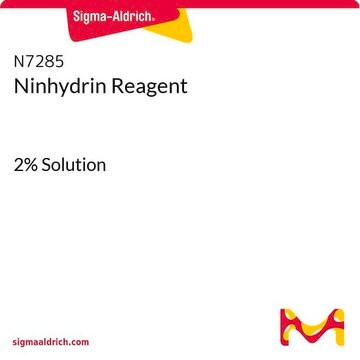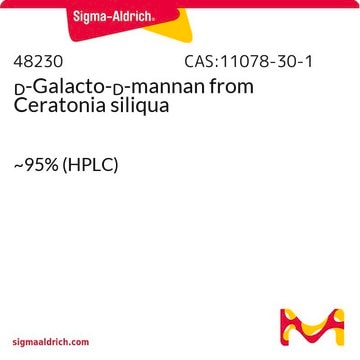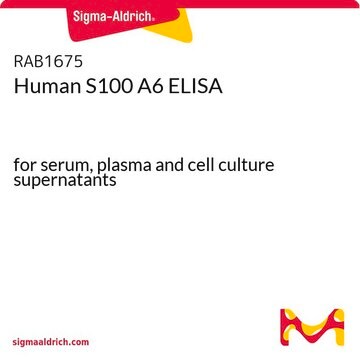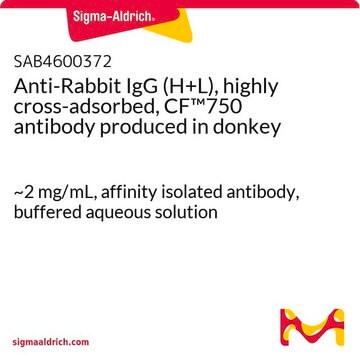If this product has an expiration or retest date, it will be shown on the Certificate of Analysis (COA, CofA). If there is no retest or expiration date listed on the product's COA, we do not have suitable stability data to determine a shelf life. For these products, the only date on the COA will be the release date; a retest, expiration, or use-by-date will not be displayed.
For all products, we recommend handling per defined conditions as printed in our product literature and website product descriptions. We recommend that products should be routinely inspected by customers to ensure they perform as expected.
For products without retest or expiration dates, our standard warranty of 1 year from the date of shipment is applicable.
For more information, please refer to the Product Dating Information document: https://www.sigmaaldrich.com/deepweb/assets/sigmaaldrich/marketing/global/documents/449/386/product-dating-information-mk.pdf
P2297
Picrylsulfonic acid solution
5 % (w/v) in H2O, BioReagent, suitable for determination of primary amines
Synonym(s):
2,4,6-Trinitrobenzenesulfonic acid solution, TNBS
Select a Size
Select a Size
About This Item
Recommended Products
product line
BioReagent
Quality Level
concentration
5 % (w/v) in H2O
suitability
suitable for determination of primary amines
storage temp.
2-8°C
SMILES string
OS(=O)(=O)c1c(cc(cc1[N+]([O-])=O)[N+]([O-])=O)[N+]([O-])=O
InChI
1S/C6H3N3O9S/c10-7(11)3-1-4(8(12)13)6(19(16,17)18)5(2-3)9(14)15/h1-2H,(H,16,17,18)
InChI key
NHJVRSWLHSJWIN-UHFFFAOYSA-N
Looking for similar products? Visit Product Comparison Guide
Related Categories
General description
Application
- to assess the efficiency of carboxymethyl lysine (CML) modifications of exposed primary amines
- to incubate zona intact bovine embryos for the differential staining of blastocysts
- to induce irritable bowel syndrome (IBS) in mice and to study its effects on Clostridium butyricum
related product
Signal Word
Danger
Hazard Statements
Precautionary Statements
Hazard Classifications
Eye Dam. 1 - Skin Corr. 1B - Skin Sens. 1
Storage Class Code
8B - Non-combustible corrosive hazardous materials
WGK
WGK 3
Flash Point(F)
Not applicable
Flash Point(C)
Not applicable
Choose from one of the most recent versions:
Certificates of Analysis (COA)
Don't see the Right Version?
If you require a particular version, you can look up a specific certificate by the Lot or Batch number.
Already Own This Product?
Find documentation for the products that you have recently purchased in the Document Library.
Customers Also Viewed
-
How can I determine the shelf life / expiration / retest date of this product?
1 answer-
Helpful?
-
-
How is shipping temperature determined? And how is it related to the product storage temperature?
1 answer-
Products may be shipped at a different temperature than the recommended long-term storage temperature. If the product quality is sensitive to short-term exposure to conditions other than the recommended long-term storage, it will be shipped on wet or dry-ice. If the product quality is NOT affected by short-term exposure to conditions other than the recommended long-term storage, it will be shipped at ambient temperature. As shipping routes are configured for minimum transit times, shipping at ambient temperature helps control shipping costs for our customers. For more information, please refer to the Storage and Transport Conditions document: https://www.sigmaaldrich.com/deepweb/assets/sigmaaldrich/marketing/global/documents/316/622/storage-transport-conditions-mk.pdf
Helpful?
-
-
この製品は水とTNBS以外に何かが含まれていますか?
1 answer-
The exact composition of this product is proprietary. No preservatives or stabilizers have been added.
Helpful?
-
-
Is this product suitable for IBD induction in mouse models?
1 answer-
As listed on the website, this product, picrylsulfonic acid solution, has been used in the following:
-to assess the efficiency of carboxymethyl lysine (CML) modifications of exposed primary amines
-to incubate zona intact bovine embryos for the differential staining of blastocysts
-to induce irritable bowel syndrome (IBS) in mice and to study its effects on Clostridium butyricumIt has not been validated in the use for IBD induction in mouse models.
Helpful?
-
-
Is Product P2297, Picrylsulfonic acid solution, supposed to be yellow?
1 answer-
Yes. This product is a clear to slightly hazy yellow solution at room temperature. The solution has a concentration of 5 w/v % in H2O (5g per 100 mL).
Helpful?
-
-
How is Product P2297, Picrylsulfonic acid solution, tested? Do you have any references for its use besides Sigma's method?
1 answer-
Sigma's suitability assay is based on a published method.1 We use a 500-fold dilution as a working solution, with glycine as a standard. Hydrochloric acid is used to stop the reaction, and to reduce yellow background due to picric acid. Sodium phosphate is used as a buffer in place of sodium bicarbonate to avoid formation of CO2 when HCl is added. Absorbance is read at 420 nm.Other procedures have been published. For example:---Twenty-five mL of 0.03 M TNBS is added to 1 mL of sample (in borate buffer), agitated to ensure complete mixing, and allowed to stand for 30 minutes at room temperature (25±1°C). No quenching step is used. In the blank, buffer replaces sample. Absorbance is read at 420 nm.2---Protocols using a more concentrated solution of picric acid (1.1 M) have been published.3Note: TNBS forms an orange complex with amines, monitored at 420 nm, but the EmM of the complexes will vary with the reacting group: for alpha-amino groups, 22.0; for epsilon-amino groups, somewhat lower; and for thiol groups, 2.25.3References:1. Satake, K. et al., J. Biochem., 47, 654 (1960).2. Snyder, S.L. and Sobocinski P.Z., Anal. Biochem., 64, 284-288 (1975).3. Fields, R., Methods in Enzymology, 25, 464-468 (1972).
Helpful?
-
-
What is the Department of Transportation shipping information for this product?
1 answer-
Transportation information can be found in Section 14 of the product's (M)SDS.To access the shipping information for this material, use the link on the product detail page for the product.
Helpful?
-
-
Is Product P2297, Picrylsulfonic acid solution, considered to be stable?
1 answer-
It is explosive when it is dry. The solution should be stored at 2-8°C in the dark. Under these conditions less than 5% decomposition will occur over five months. At 37°C, 50% decomposition occurred in 60 days. Picrylsulfonic acid decomposes to picric acid, crystals of which may form in the solution, but this impurity causes no interference in usage. The solution may also contain a trace amount of 2,4-dinitrophenol (typically °C may enhance shelf-life of stock solutions.
Helpful?
-
-
In general, what is Product P2297, Picrylsulfonic acid solution, used for?
1 answer-
Picrylsulfonic acid has been used 1) As a hydrophilic modifying reagent[1]; 2) To make derivatives with amino compounds, which can be regenerated with hydrazine [2].
Helpful?
-
-
What are the suggested storage conditions for Product P2297, Picrylsulfonic acid solution?
1 answer-
Store Product No. P2297 at 2-8°C in the dark.
Helpful?
-
Active Filters
Our team of scientists has experience in all areas of research including Life Science, Material Science, Chemical Synthesis, Chromatography, Analytical and many others.
Contact Technical Service










